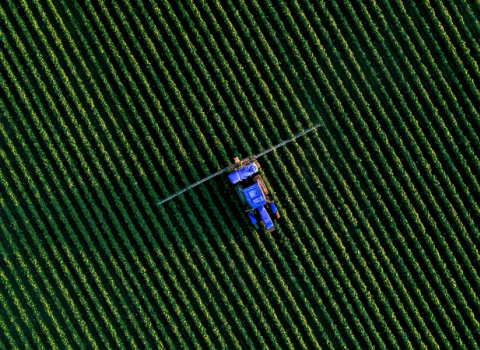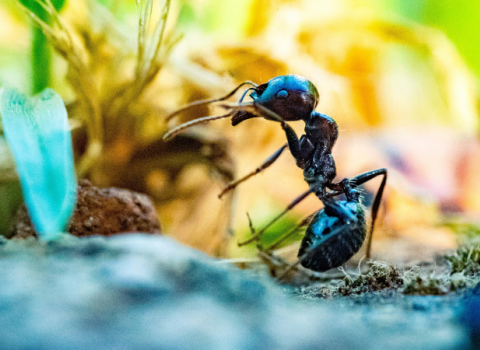The need to link biodiversity loss with other crises is acknowledged; now researchers need help do this

Photo credits: Juliette Portala
A lack of support for researchers to navigate different disciplines and connect biodiversity loss with other major crises is hampering the development of appropriate policies, according to international experts in a report published this week.
The Intergovernmental Science-Policy Platform on Biodiversity and Ecosystem Services (IPBES) studied the links between the biodiversity, water, food and health crises, and the causes of biodiversity loss and drivers for change.
Despite being so interconnected, “Decisions to address them are often taken in isolation, resulting in potential misalignment, unplanned trade-offs and/or unintended consequences,” the IPBES report concludes.
Diana Mangalagiu, associate fellow at Oxford University, professor at Neoma Business School, France, and adjunct professor at Sciences Po, Paris, who is a lead author of the paper, says that there are not enough researchers investigating this nexus – but that is not because they don’t want to do so.
In her view, one of the main issues is that institutions do not encourage researchers to work across disciplines.
“There are not that many places in the world where you have welcoming institutions saying, ‘We are aware that you are not going to be published in Science or the Proceedings of the National Academy of Sciences tomorrow morning, but no problem! We know that it’s very good research, and we encourage it’,” Mangalagiu told Science|Business.
Another difficulty lies in bridging between the specific knowledge bases that researchers hold. The fact that high-ranking journals are “very thematic” does not help, Mangalagiu noted. Nor does project evaluation, sometimes performed by “siloed” evaluators.
“Whenever you put cutting edge interdisciplinary work in the proposals, most of the time these get rejected because of the way evaluation is done, the criteria which are used for the evaluation, and also the training of the evaluators themselves,” she said.
“Institutional issues, but also governance and performance evaluation: these are the biggest obstacles in terms of research … But there is a lot of appetite in the research circle, because people want to have an impact,” she added.
Making connections
Amid the many links identified, IPBES sets out how biodiversity loss and climate change are compounding each other. Ecosystems help mitigate climate change by acting as a carbon sink; meanwhile, biodiversity loss hampers the ability of these ecosystems to capture carbon, thereby increasing greenhouse gas concentrations and speeding up climate change.
But the biodiversity and climate crises are still handled separately. As Mangalagiu noted, it took almost 50 years to put climate on the agenda, so putting biodiversity together with climate is another big hill to climb.
Global biodiversity declined by 2% to 11% in the past century due to land-use change, which IPBES deems one of the major drivers of biodiversity loss, alongside invasive alien species, the direct exploitation of organisms, climate change and pollution.
After months of deadlock, earlier this year the European Commission adopted the Nature Restoration Law, which calls on member states to restore at least 20% of land and seas, as part of a strategy to reverse biodiversity loss by 2030.
The European Research Council (ERC) and European Research Executive Agency (REA) have backed projects in Horizon 2020 and Horizon Europe programmes that show how biodiversity loss underpins daily life, such as BIONEXT; how the health of the deep-sea affects the economy, in iAtlantic; and how restoring wetlands benefits local communities, in the WaterLANDS project.
More projects will be selected next year under calls by the European Biodiversity Partnership, which Mangalagiu worked on. “I was in the scoping of the Biodiversa+ calls,” she said. “We actually tried to … design some of these interlinkages in the calls.”
For the remainder of Horizon Europe and the successor research programme FP10, she suggested that, “Whenever projects or calls are going out, people should be asked explicitly to address [integration].”
Researchers should be prompted to look into the linkages and consequences both predictable and unintended – beyond the subject of the call itself, “to at least make people think [about those],” Mangalagiu said.
Biodiversa+, which is set to run for seven years, has an overall budget of €800 million, including €165 million from the EU.
Brussels has pledged to allocate 7.5% of the next multi-annual 2021-2027 budget to EU biodiversity targets, and it plans to increase this share to 10% in 2026 and 2027.





 A unique international forum for public research organisations and companies to connect their external engagement with strategic interests around their R&D system.
A unique international forum for public research organisations and companies to connect their external engagement with strategic interests around their R&D system.